REE-Rich Turonian Phosphates in the Bohemian Cretaceous Basin, Czech Republic: Assessment as Source of Critical Elements and Implications for Future Exploration
Abstract
1. Introduction
2. Geological Setting
2.1. Lithostratigraphy of the Phosphate-Bearing Sequences
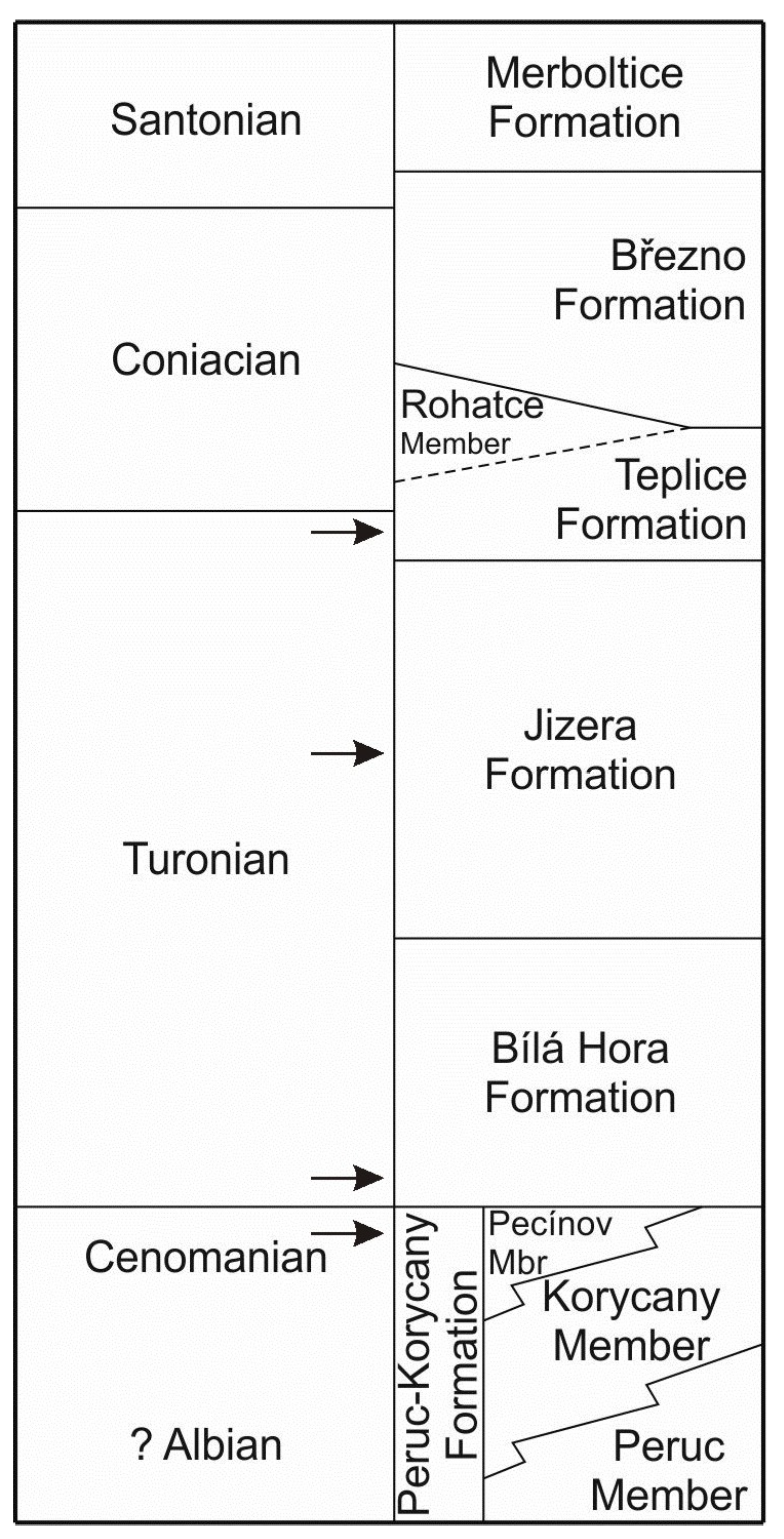
2.1.1. Peruc-Korycany Formation (Cenomanian)
2.1.2. Bílá Hora Formation (Lower Turonian)
2.1.3. Jizera and Teplice Formations (Middle–Upper Turonian)
3. Samples and Methods
4. Petrology
4.1. Petrography
4.2. Mineralogy
5. Chemical Composition
5.1. Major and Trace Elements
| Ppm | Pecínov Quarry (9 Samples) 1 | Nová Ves Quarry (3 Samples) 1 | Česká Třebová Quarry (2 Samples) 2 | Březinka Chvalka Outcrop (2 Samples) 2 | Úpohlavy Quarry (9 Samples) 1 | Býčkovice Road-Cut (1 Sample) 1 | Rtyně v Podkrkonoší (1 Sample) 2 |
|---|---|---|---|---|---|---|---|
| Sc | 12.6 | 5.6 | 10.0 | 4.0 | 9.8 | 2.4 | 2.3 |
| Cr | 11.6 | 5.3 | 10.5 | 35.0 | 1.1 | 4.8 | 23.0 |
| Co | 3.8 | 3.7 | 7.0 | 4.0 | 6.0 | 3.0 | n.d. |
| Ni | 18.2 | 13.4 | 12.0 | 6.5 | 26.3 | 11.3 | 18.2 |
| Cu | 16.6 | 14.5 | 10.5 | 4.0 | 20.1 | 19.8 | n.d. |
| Zn | 60.3 | 17.8 | 23.0 | 14.5 | 599.9 | 12.8 | n.d. |
| Rb | 11.7 | 8.5 | 48.5 | n.d. | 3.6 | 8.8 | n.d. |
| Y | 213 | 74 | 548 | 131 | 368 | 144 | 153 |
| Zr | 40.3 | 16.6 | 45.5 | 151 | 47.4 | 22.5 | 18.1 |
| Cd | 0.07 | 0.12 | 3.0 | 3.0 | 0.74 | 0.12 | n.d. |
| Ba | 131 | 27.9 | 55.0 | 62.5 | 308 | 512 | 92.5 |
| W | 1.4 | 0.9 | 11.5 | n.d. | 1.0 | 1.0 | n.d. |
| Pb | 13.8 | 16.7 | 12.0 | 10.0 | 26.9 | 22.2 | n.d. |
| Th | 8.1 | 1.7 | 3.5 | 6.0 | 0.8 | 1.0 | 2.2 |
| U | 29.7 | 37.9 | 30.5 | 29.5 | 28.9 | 12.5 | 10.4 |
| ∑REE | 873 | 325 | 1338 | 526 | 1300 | 529 | n.d. |
| Ce-anomaly * | 0.25 | −0.06 | −0.30 | 0.06 | 0.02 | −0.12 | - |
| Ce/La | 4.84 | 1.58 | 0.84 | 2.58 | 1.88 | 1.28 | - |
5.2. Critical Elements
5.3. Recovery of REE from Phosphates
6. Phosphogenesis
6.1. Main Phosphogenic Events in the BCB
6.2. Origin and Phosphogenic Environment

6.3. Comparable Cretaceous Phosphogenic Events in Europe
7. Potential Phosphorite Exploration Targets in the BCB
8. Conclusions
Author Contributions
Funding
Institutional Review Board Statement
Informed Consent Statement
Data Availability Statement
Acknowledgments
Conflicts of Interest
References
- Tulsidas, H.; Gabriel, S.; Kiegiel, K.; Heneklaus, N. Uranium resources in EU phosphate imports. Resour. Policy 2019, 61, 151–156. [Google Scholar] [CrossRef]
- European Commission. Report on Critical Raw Materials in the Circular Economy; European Commission: Brussels, Belgium, 2018. [Google Scholar]
- Žítt, J.; Nekvasilová, O. New occurrences of phosphorites in the Upper Cretaceous of the Prague and Kolín lithofacial regions (Czechoslovakia). Bohemia Cent. 1992, 21, 5–18. [Google Scholar]
- Žítt, J.; Nekvasilová, O. Epibionts, their hard-rock substrates, and phosphogenesis during the Cenomanian-Turonian boundary interval (Bohemian Cretaceous Basin, Czech Republic). Cretac. Res. 1996, 17, 715–739. [Google Scholar] [CrossRef]
- Laurin, J. Sedimentary Discontinuities with Evidences of Phosphatic Mineralization as a Record of the Changes of Sea Level; Bohemian Cretaceous Basin. Master’s Thesis, Charles University, Prague, Czech Republic, 1996; p. 122. (In Czech). [Google Scholar]
- Uličný, D.; Hladíková, J.; Attrep, M.J., Jr.; Čech, S.; Hradecká, L.; Svobodová, M. Sea-level changes and geochemical anomalies across the Cenomanian–Turonian boundary: Pecínov quarry, Bohemia. Palaeogeogr. Palaeoclim. Palaeoecol. 1997, 132, 265–285. [Google Scholar] [CrossRef]
- Wiese, F.; Čech, S.; Ekrt, B.; Košťák, M.; Mazuch, M.; Voigt, S. The Upper Turonian of the Bohemian Cretaceous Basin (Czech Republic) exemplified by the Úpohlavy working quarry: Integrated stratigraphy and paleoceanography of a gateway to the Tethys. Cretac. Res. 2004, 25, 329–352. [Google Scholar] [CrossRef]
- Čech, S.; Hradecká, L.; Svobodová, M.; Švábenická, L. Cenomanian and Cenomanian-Turonian boundary in the southern part of the Bohemian Cretaceous Basin, Czech Republic. Bull. Geosci. 2005, 80, 321–354. [Google Scholar]
- Žítt, J.; Vodrážka, R.; Hradecká, L.; Svobodová, M.; Zágoršek, K. Late Cretaceous environments and communities as recorded at Chrtníky (Bohemian Cretaceous Basin, Czech Republic). Bull. Geosci. 2006, 81, 43–79. [Google Scholar] [CrossRef]
- Vodrážka, R.; Sklenář, J.; Čech, S.; Laurin, J.; Hradecká, L. Phosphatic intraclasts in shallow-water hemipelagic strata: A source of palaeoecological, taphonomic and biostatigraphic data (Upper Turonian, Bohemian Cretaceous Basin). Cretac. Res. 2009, 30, 204–222. [Google Scholar] [CrossRef]
- Al-Bassam, K.S.; Magna, T. Distribution and significance of rare earth elements in Cenomanian-Turonian phosphate components and mudstones from the Bohemian Cretaceous Basin, Czech Republic. Bull. Geosci. 2018, 93, 347–368. [Google Scholar] [CrossRef]
- Košťák, M.; Čech, S.; Uličný, D.; Sklenář, J.; Ekrt, B.; Mazuch, M. Ammonites, inoceramids, and stable carbon isotopes of the Cenomanian-Turonian OAE2 interval in Central Europe: Pecínov quarry, Bohemian Cretaceous Basin (Czech Republic). Cretac. Res. 2018, 87, 150–173. [Google Scholar] [CrossRef]
- Al-Bassam, K.S.; Magna, T.; Vodrážka, R.; Čech, S. Mineralogy and geochemistry of marine glauconitic siliciclasts and phosphates in selected Cenomanian-Turonian units, Bohemian Cretaceous Basin, Czech Republic: Implications for provenance and depositional environment. Geochemistry 2019, 79, 347–368. [Google Scholar] [CrossRef]
- Čech, S.; Hradecká, L.; Laurin, J.; Štaffen, Z.; Švábenická, I.; Uličný, D. Úpohlavy quarry: Record of the late Turonian sea-level oscillations and synsedimentary tectonic activity. In Stratigraphy and Facies of the Bohemian-Saxonian Cretaceous Basin. Field Trip Guide, 5th International Cretaceous Symposium; Springer: Berlin/Heidelberg, Germany, 1996; pp. 32–42. [Google Scholar]
- Notholt, A.J.G.; Sheldon, R.P.; Davidson, D.F. (Eds.) Phosphate Deposits of the World: Volume 2, Phosphate Rock Resources; Cambridge University Press: Cambridge, UK, 1989; pp. 365–368. [Google Scholar]
- Decrée, S.; Burlet, C.; Goovaerts, T.; Batista, M.J.; de Oliveira, D.P.S.; Al-Bassam, K.; Malyuk, B.; Coint, N.; McGrath, E.; Bauert, H. Overview of the European phosphate deposits and occurrences: A project dedicated to phosphate mineralizations and associated critical raw materials. In Proceedings of the SGA Biennial Meeting; Royal Belgian Institute of Natural Sciences: Brussels, Belgium, 2019. [Google Scholar]
- Uličný, D. Depositional systems and sequence stratigraphy of coarse-grained deltas in a shallow-marine, strike-slip setting: The Bohemian Basin, Czech Republic. Sedimentology 2001, 48, 599–628. [Google Scholar] [CrossRef]
- Valečka, J.; Skoček, V. Late Cretaceous lithoevents in the Bohemian Cretaceous Basin, Czechoslovakia. Cretac. Res. 1991, 12, 561–577. [Google Scholar] [CrossRef]
- Čech, S.; Klein, V.; Kříž, J.; Valečka, J. Revision of the Upper Cretaceous stratigraphy of the Bohemian Cretaceous Basin. Věstn. Ústřed. Ust. Geol. 1980, 55, 277–296. [Google Scholar]
- Uličný, D. Sedimentation in a reactivated intra-continental strike-slip fault zone: The Bohemian Cretaceous Basin, Central Europe. Gaea Heidelb. 1997, 3, 347. [Google Scholar]
- Žítt, J.; Nekvasilová, O.; Hradecká, L.; Svobodová, M.; Záruba, B. Rocky coast facies of the Unhost-Tursko High (Late Cenomanian-Turonian, Bohemian Cretaceous Basin). Acta Musei Natl. Pragae Ser. B Hist. Nat. 1998, 54, 79–116. [Google Scholar]
- Vodrážka, R.; Bubík, M.; Švábenická, L.; Žítt, J. Late Cretaceous-Lower Turonian transgressive deposits near Kutná Hora and Kolin (Central Bohemia, Bohemian Cretaceous Basin). In Proceedings of the TMS Foraminifera and Nannofossil Groups Spring Meeting 2013, Prague, Czech Republic, 19–22 June 2013; p. 28. [Google Scholar]
- Al-Bassam, K.S.; Halodová, P. Fossil bacteria in Cenomanian–Turonian phosphate nodules and coprolites, Bohemian Cretaceous Basin, Czech Republic. Ann. Soc. Geol. Pol. 2018, 88, 257–272. [Google Scholar] [CrossRef]
- Al-Bassam, K.S. Stable carbon and oxygen isotopes of some carbonate-fluorapatites from Cenomanian and Turonian sequences, Bohemian Cretaceous Basin, Czech Republic. Iraqi Geol. J. 2018, 51, 1–16. [Google Scholar]
- Gulbrandsen, R.A. Relation of carbon dioxide content of apatite of the Phosphoria Formation to regional facies. Mt. Geol. 1970, 8, 81–84. [Google Scholar]
- Dempírová, L.; Šikl, J.; Kašičková, R.; Zoulková, V.; Kříbek, B. The evaluation of precision and relative error of the main components of silicate analyses in Central Laboratory of the Czech Geological Survey. Geosci. Res. Rep. 2010, 43, 326–330. [Google Scholar]
- Ackerman, L.; Magna, T.; Rapprich, V.; Upadhyay, D.; Krátký, O.; Čejková, B.; Erban, V.; Kochergina, Y.U.V.; Hrstka, T. Contrasting petrogenesis of spatially related carbonatites from Samalpatti and Sevattur, Tamil Nadu, India. Lithos 2017, 284–285, 257–275. [Google Scholar] [CrossRef]
- Kechicheda, R.; Laouara, R.; Bruguierc, O.; Laouar-Salmia, S.; Ameur-Zaimecheb, O.; Foufoud, A. Preliminary data REE in Algerian phosphorites: A comparative study and paleo-redox insights. “SYMPHOS 2015”, 3rd International Symposium on Innovation and Technology in the Phosphate Industry. Procedia Eng. 2016, 138, 19–29. [Google Scholar]
- Abed, A.M.; Jaber, O.; Alkuisi, M.; Sadaqah, R. Rare earth elements and uranium geochemistry in the Al-Kora phosphorite province, Late Cretaceous, northeastern Jordan. Arab. J. Geosci. 2016, 9, 187–206. [Google Scholar] [CrossRef]
- Aba-Husain, A.; Al-Bassam, K.; Al-Rawi, Y. Rare Earth elements geochemistry of some Paleocene carbonate fluorapatites from Iraq. Iraqi Bull. Geol. Min. 2010, 6, 81–94. [Google Scholar]
- Altschuler, Z.S. The geochemistry of trace elements in marine phosphorites. Part I: Characteristics, abundances and enrichment. Mar. Phosphorites 1980, 29, 19–30. [Google Scholar]
- Wright, J.; Schrader, H.; Holserab, W.T. Paleoredox variations in ancient oceans recorded by rare earth elements in fossil apatite. Geochim. Cosmochim. Acta 1987, 51, 631–644. [Google Scholar] [CrossRef]
- Haskin, M.A.; Haskin, L.A. Rare earths in Europian shales: A redetermination. Science 1966, 154, 507–509. [Google Scholar]
- Zhang, P. Comprehensive recovery and sustainable development of phosphate resources. Procedia Eng. 2014, 83, 37–51. [Google Scholar] [CrossRef]
- Kremer, R.A.; Chokshi, J.C. Fate of rare earths elements in mining/beneficiation of Florida phosphate rocks and conversion to DAP fertilizers. In Research Report; Mobile Mining and Minerals Company: Nichols, FL, USA, 1989. [Google Scholar]
- Santos, A.J.G.; Mazzilli, B.P.; Favoro, D.I.T. Partitioning of radionuclides and trace elements in phosphogypsum and its source materials based on sequential extraction methods. J. Environ. Radioact. 2006, 87, 52–61. [Google Scholar] [CrossRef]
- Altschuler, Z.S.; Berman, S.; Cuttitta, F. Rare earths in phosphorites-Geochemistry and potential recovery. USGS Prof. Pap. 1967, 575-B, 125–135. [Google Scholar]
- Pereira, F.; Bilal, E. Phosphoric acid extraction and rare earth recovery from apatites of the Brazilian phosphatic ores. Rom. J. Miner. Depos. 2012, 85, 49–52. [Google Scholar]
- Laurino, J.; Mustacato, J. The Extraction and Recovery of Rare Earth Elements from Phosphate Using PX 107 and Chelok Polymers; Florida Industrial and Phosphate Research Institute: Bartow, FL, USA, 2015. [Google Scholar]
- Barron, E.J.; Thompson, S.L.; Schneder, S.H. A warm, equable Cretaceous: The nature of the problem. Earth Sci. Rev. 1983, 19, 305–338. [Google Scholar] [CrossRef]
- Fletcher, T.L.; Greenwood, D.R.; Moss, P.T.; Salisbury, S.W. Paleoclimate of the Late Cretaceous (Cenomanian-Turonian) portion of the Winton Formation, Central-Western Queensland, Australia: New observations based on CLAMP and Bioclimatic analysis. Palaios 2014, 29, 121–128. [Google Scholar] [CrossRef]
- Bottini, C.; Erba, E. Paleoclimate and Paleoecology of Calcareous Nannofossils; EGU General Assembly: Vienna, Austria, 2016. [Google Scholar]
- Caracciolo, L.; Pera, L.P.; Muto, F.; Perri, F. Sandstone petrology and mudstone geochemistry ofthe Peruc-Korycany Formation (Bohemian Cretaceous Basin, Czech Republic). Int. Geol. Rev. 2011, 53, 1003–1031. [Google Scholar] [CrossRef]
- Compton, J.; Mallinson, D.; Glenn, C.R.; Fillipelli, G.; Folmi, K.; Shields, G.; Zanin, Y. Variations in the global phosphorus cycle. Marine authegenesis from global to microbial. Soc. Sedim. Geol. (SEPM) Spec. Publ. 2000, 66, 21–33. [Google Scholar]
- Mort, H. Biogeochemical Changes during the Cenomanian–Turonian Oceanic Anoxic Event (OAE 2). Ph.D. Thesis, University of Neuchatel, Neuchâtel, Switzerland, November 2006; p. 197. [Google Scholar]
- Glenn, C.R.; Arthur, M.A. Petrology and major element geochemistry of Peru margin phosphorites and associated diagenetic minerals: Authigenesis in modern organic-rich sediments. Mar. Geol. 1988, 80, 231–267. [Google Scholar] [CrossRef]
- Glenn, C.R.; Arthur, M.A. Anatomy and origin of a Cretaceous phosphorite-greensand giant, Egypt. Sedimentology 1990, 37, 123–154. [Google Scholar] [CrossRef]
- Arning, E.T.; Birgel, D.; Brunner, B.; Peckmann, J. Bacterial formation of phosphatic laminites off Peru. Geobiology 2009, 7, 295–307. [Google Scholar] [CrossRef] [PubMed]
- Cosmidis, J.; Benzerara, K.; Menguy, N.; Arning, E. Microscopy evidence of bacterial microfossils in phosphorite crusts of the Peruvian shelf: Implication for phosphogenesis mechanisms. Chem. Geol. 2013, 359, 10–22. [Google Scholar] [CrossRef]
- Hiatt, E.E.; Pufahl, P.K.; Edwards, C.T. Sedimentary phosphate and associated fossil bacteria in a Paleoproterozoic tidal flat in the 1.85Ga Michigamme Formation, Michigan, USA. Sedim. Geol. 2015, 319, 24–39. [Google Scholar] [CrossRef]
- Benmore, R.A.; Coleman, M.L.; McArthur, J.M. Origin of sedimentary francolite from its sulphur and carbon isotope composition. Nature 1983, 302, 516–518. [Google Scholar] [CrossRef]
- Odin, G.S.; Matter, A. Origin of glauconites. Sedimentology 1981, 28, 611–641. [Google Scholar] [CrossRef]
- Amorosi, A. Glaucony and sequence stratigraphy: A conceptual framework of distribution in siliciclastic sequences. J. Sedim. Res. 1995, 65, 419–425. [Google Scholar]
- Arthur, M.A.; Jenkyns, H.C. Phosphorites and paleoceanography. In Proceedings of the 26. International Geological Congress, Paris, France, 7 July 1980; pp. 83–96. [Google Scholar]
- De Baar, H.J.W.; Bacon, M.P.; Brewer, P.G. Rare-earth distributions with a positive Ce anomaly in the western North Atlantic Ocean. Nature 1983, 301, 324–327. [Google Scholar] [CrossRef]
- Høgdahl, O.T.; Melsom, S.; Bowen, V.T. Neutron activation analysis of lanthanide elements in seawater. Am. Chem. Soc. 1968, 73, 308–325. [Google Scholar]
- Walaszczyk, I. Mid-Cretaceous events at the marginal part of the Central European Basin (Annopol-on-Vistula section, Central Poland). Acta Geol. Pol. 1987, 37, 61–74. [Google Scholar]
- Ilyn, A. Mid-Cretaceous phosphate platforms of the Russian Craton. Sediment. Geol. 1997, 113, 125–135. [Google Scholar] [CrossRef]
- Carson, G.A.; Crowley, S.F. The glauconite–phosphate association in hardgrounds: Examples from the Cenomanian of Devon, southwest England. Cretac. Res. 1993, 14, 69–89. [Google Scholar] [CrossRef]
- Tzifas, I.T.; Godelitsas, A.; Magganas, A.; Androulakaki, E.; Eleftheriou, G.; Mertzimekis, T.J.; Perraki, M. Uranium-bearing phosphatized limestones of NW Greece. J. Geochem. Explor. 2014, 143, 62–73. [Google Scholar] [CrossRef]
- Tzifas, I.T.; Glasmacher, U.A.; Misaelides, P.; Godelitsas, A.; Gkamaletsos, P.; Goettlicher, J.; de Godoy, D.F. Uranium-bearing francolites present in organic-rich limestones of NW Greece: A preliminary study using synchrotron radiation and fission track techniques. J. Radioanal. Nucl. Chem. 2017, 311, 465–472. [Google Scholar] [CrossRef]
- Al-Bassam, K.S. The Mineralogy and Geochemistry of the Marine Sedimentary Phosphate Deposits of Iraq and other Areas of the East Mediterranean. Ph.D. Thesis, University of Wales, Cardiff, UK, 1974; p. 360. [Google Scholar]
- Abed, A.M. The eastern Mediterranean phosphorite giants: An interplay between tectonics and upwelling. GeoArabia 2013, 18, 67–94. [Google Scholar]
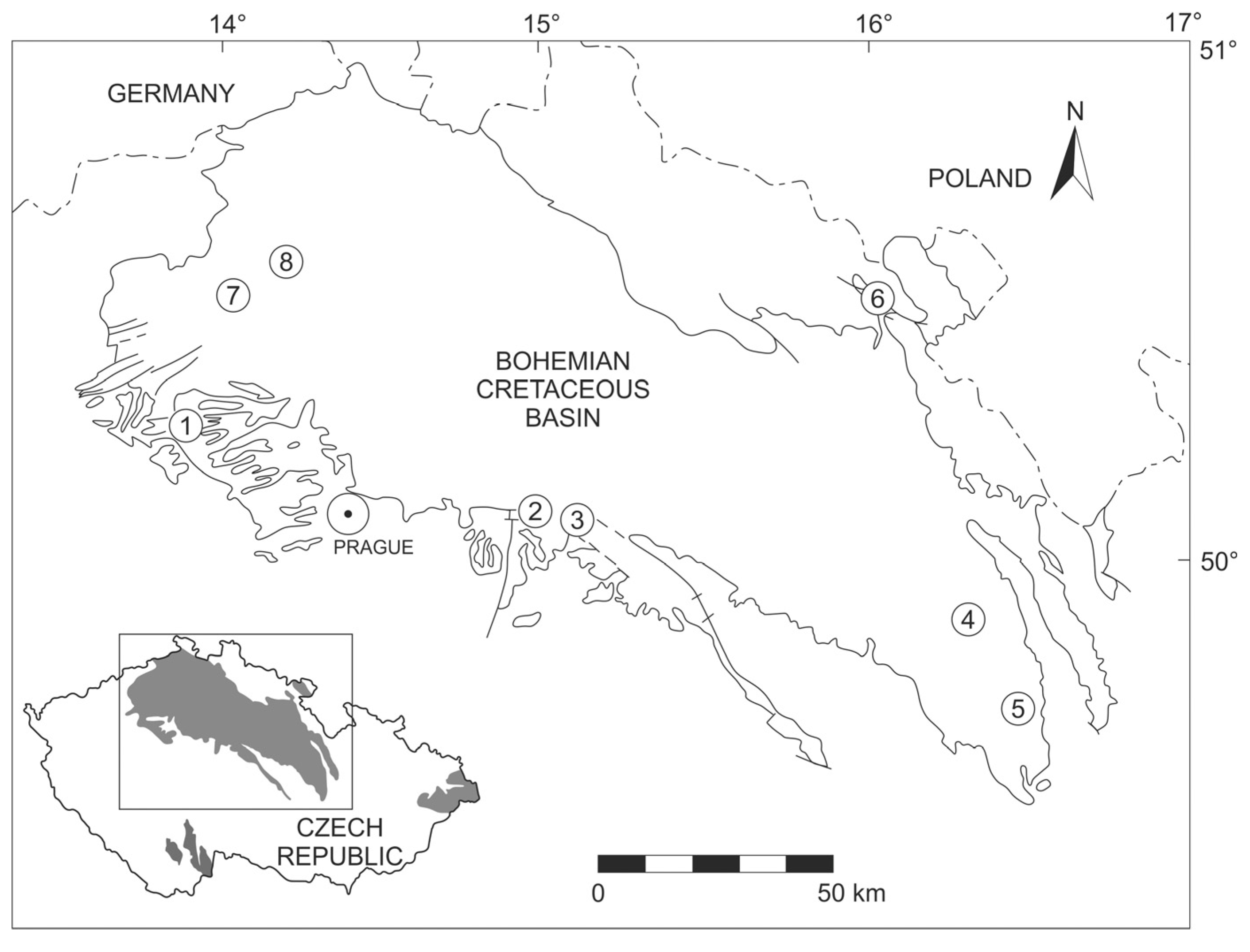
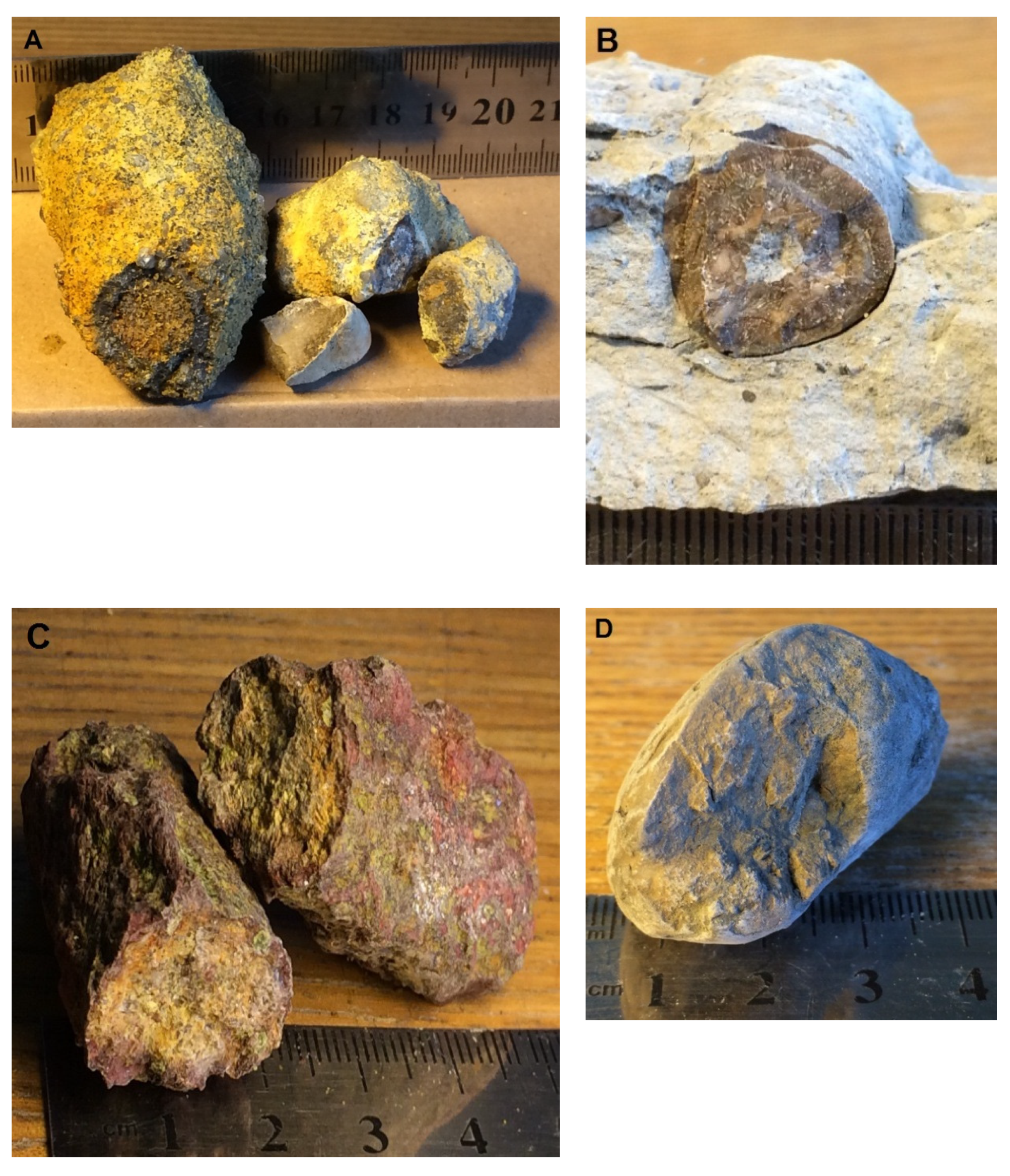

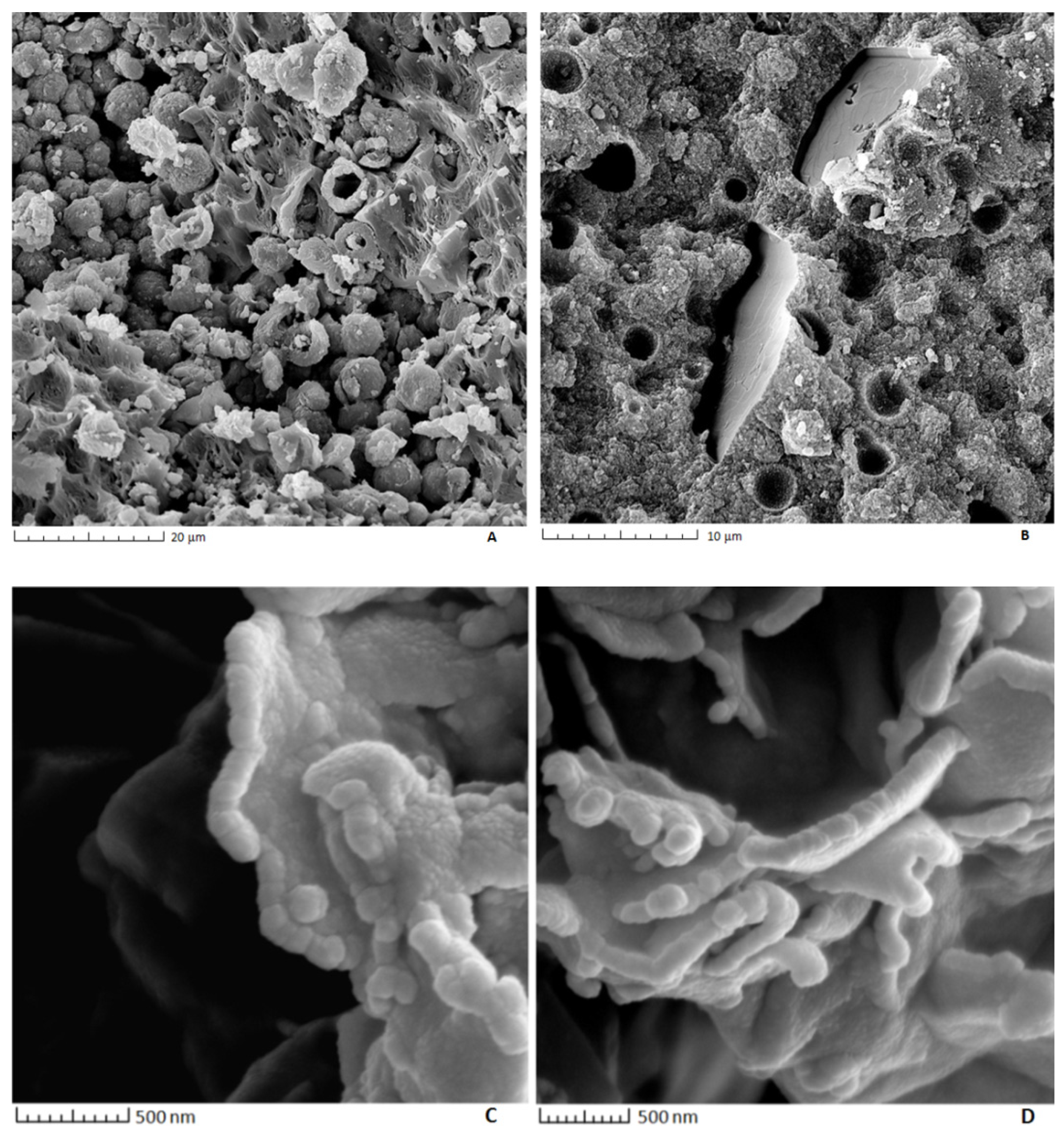
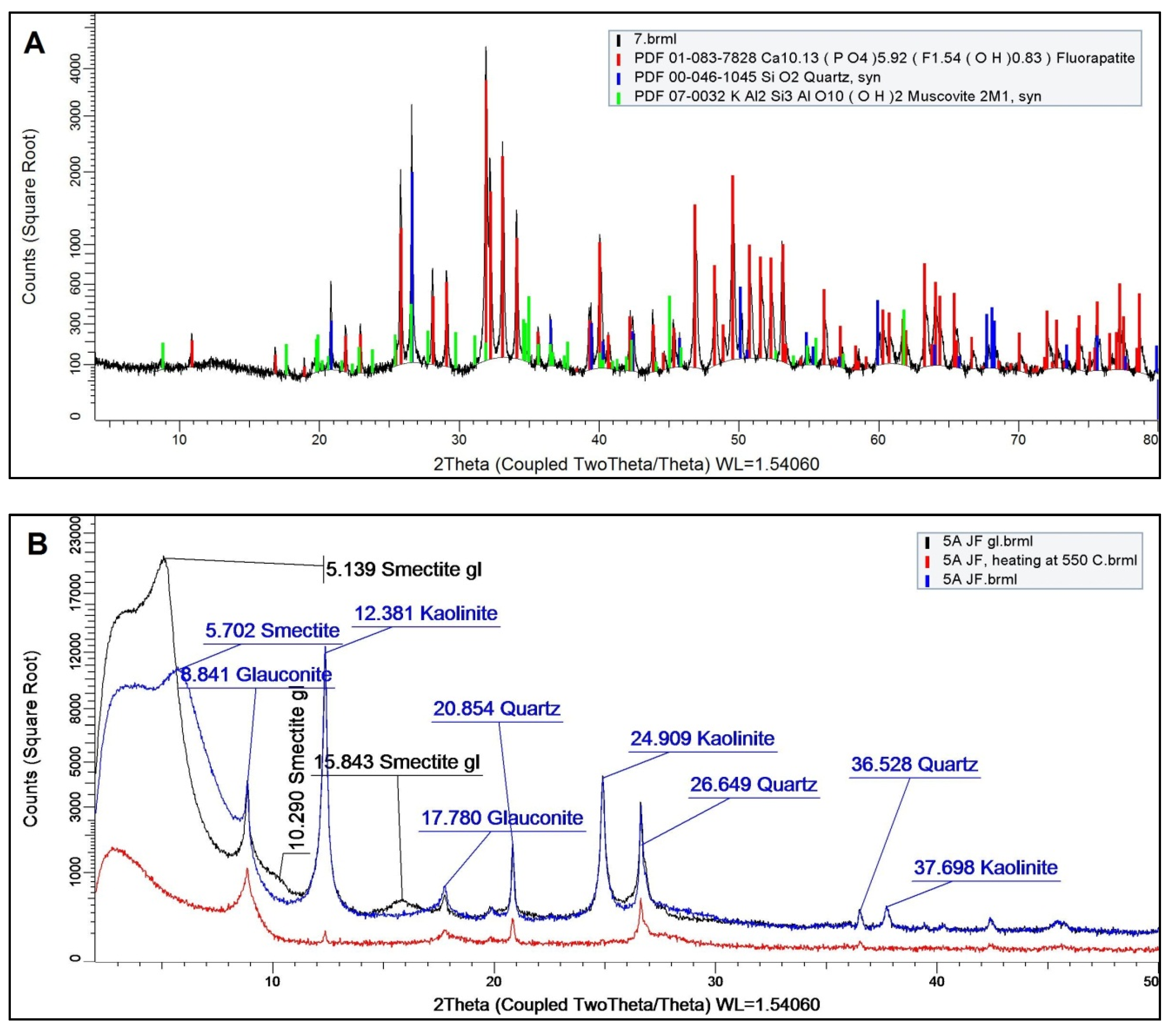
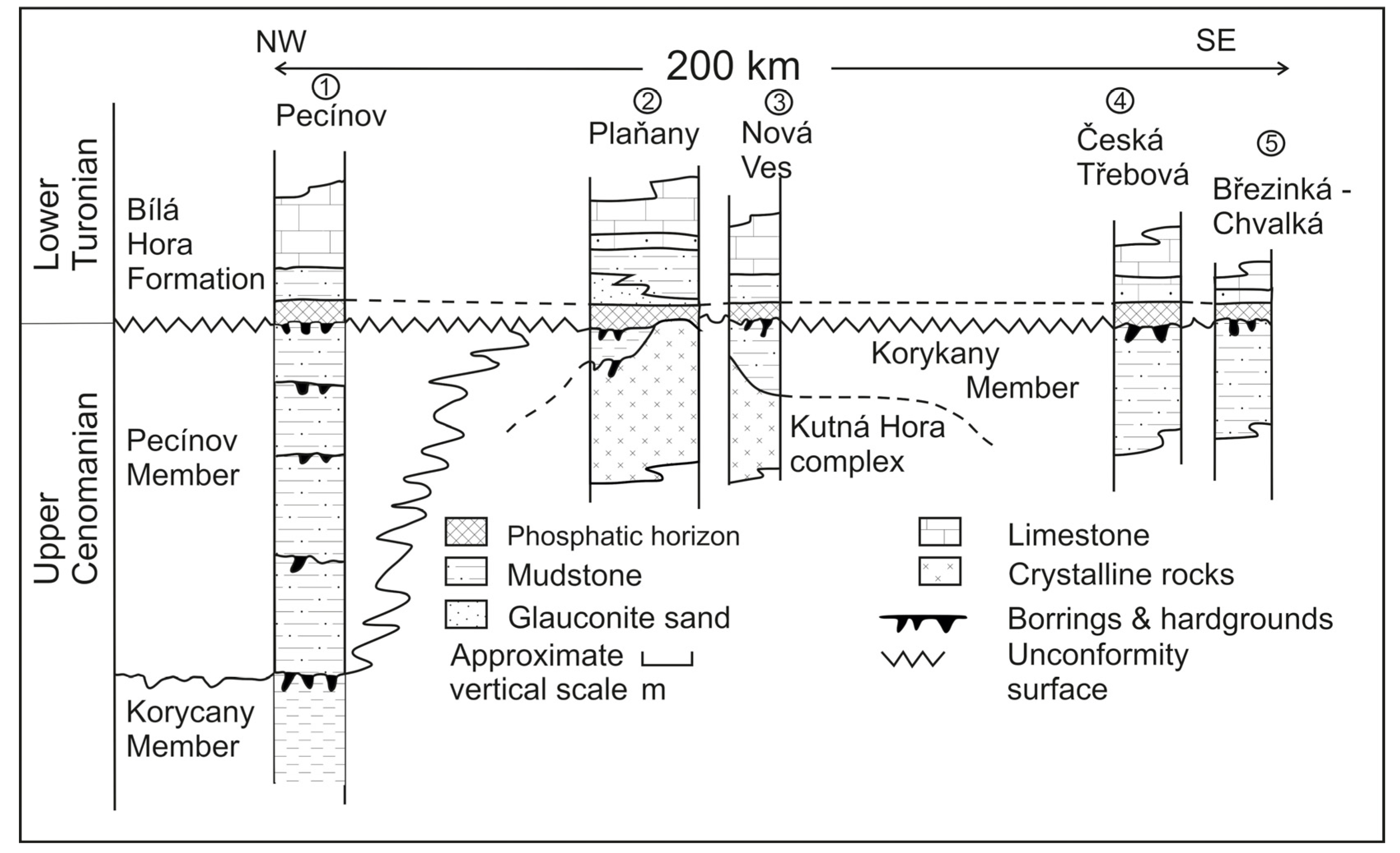
| Locality | Coordinates | Lithology | Stratigraphy |
|---|---|---|---|
| Pecínov quarry | N 50.12933 E 13.91716 | Phosphate nodules, phosphate molds, and skeletal remains in black and dark gray glauconitic mudstone. | Lower Turonian: Base of Bílá Hora Formation overlying Pecínov Member. |
| Planany quarry | N 50.05166 E 15.01666 | Reworked phosphoclasts of sponges, intraclasts, skeletal remains, sponges, and tube-fills. | Lower Turonian: Base of Bílá Hora Formation overlying Kutna Hora Complex. |
| Nová Ves quarry | N 50.05533 E 15.13183 | Phosphoclasts of shark teeth, sponges, intraclasts, and tube-fills topping hardground. | Lower Turonian: Base of Bílá Hora Formation overlying Korycany Member. |
| Česká Třebová | N 49.95933 E 16.50033 | Phosphate tube-fills and phosphate cement in varicolored bioturbated and glauconitic silty nodular hardground. | Lower Turonian: Base of Bílá Hora Formation overlying Korycany Member. |
| Březinka–Chvalka | N 49.63400 E 16.59017 | Dark brown phosphate nodules and tube-fills in sandy bioturbated and glauconitic hardground. | Lower Turonian: Base of Bílá Hora Formation overlying Korycany Member. |
| Rtyně v Podkrkonoší | N 50.51450 E 16.06800 | Dark brown angular phosphate intraclasts and skeletal remains in silty, recrystallized limestone. | Middle–Upper Turonian, Jizera Formation? |
| Úpohlavy quarry | N 50.46650 E 14.06416 | Dark brown phosphate coprolites, tube-fills, and fish scales in dark gray lime-mudstone | Upper Turonian: Base of Teplice Formation, Lower Coprolite Bed. |
| Býčkovice road-cut | N 50.55117 E 14.22050 | Phosphatic sponges, tube-fills, and intraclasts in lime-mudstone | Upper Turonian: Base of Teplice Formation. |
| Wt. % | Nodules | Coprolites | Cement | Bioclasts |
|---|---|---|---|---|
| SiO2 | 1.96 | 0.82 | 1.37 | n.a. |
| Al2O3 | 0.85 | 0.26 | 0.49 | 0.12 |
| Fe2O3 | 0.36 | 0.31 | 1.02 | 0.31 |
| CaO | 48.31 | 48.79 | 48.80 | 47.88 |
| SrO | 0.39 | 0.47 | 0.24 | 0.52 |
| MgO | 0.23 | 0.20 | 0.33 | 0.22 |
| K2O | 0.17 | 0.16 | 0.38 | n.a. |
| Na2O | 0.81 | 0.65 | 0.84 | 0.75 |
| P2O5 | 31.14 | 31.73 | 30.76 | 36.61 |
| SO3 | 1.45 | 1.68 | 1.38 | 1.43 |
| F | 4.47 | 4.40 | 5.09 | 3.58 |
| Wt. % | Pecínov Quarry (9 Samples) 1 | Nová Ves Quarry (3 Samples) 1 | Česká Třebová Quarry (2 Samples)2 | Březinka Chvalka Outcrop (2 Samples) 2 | Úpohlavy Quarry (9 Samples) 1 | Býčkovice Road-Cut (1 Sample) 1 | Rtyně v Podkrkonoší (1 Sample) 2 |
|---|---|---|---|---|---|---|---|
| SiO2 | 13.37 | 9.06 | 20.73 | 37.91 | 2.05 | 6.57 | 17.02 |
| TiO2 | 0.12 | 0.07 | 0.11 | 0.16 | 0.03 | 0.05 | 0.11 |
| Al2O3 | 3.01 | 1.59 | 1.14 | 2.30 | 0.78 | 1.52 | 3.47 |
| Fe2O3 | 2.13 | 1.24 | 2.56 | 1.87 | 1.19 | 1.71 | 2.50 |
| FeO | 0.42 | 0.20 | 0.36 | 0.45 | 0.18 | 0.21 | 0.22 |
| MgO | 0.54 | 0.45 | 0.47 | 0.35 | 0.34 | 0.44 | 0.56 |
| MnO | 0.018 | 0.025 | 0.015 | 0.023 | 0.017 | 0.019 | 0.035 |
| CaO | 40.77 | 47.32 | 39.56 | 29.83 | 51.13 | 50.30 | 38.41 |
| SrO | 0.197 | 0.200 | 0.072 | 0.085 | 0.304 | 0.15 | 0.099 |
| Na2O | 0.88 | 0.59 | 0.12 | 0.32 | 0.52 | 0.47 | 0.21 |
| K2O | 0.79 | 0.28 | 1.12 | 0.77 | 0.15 | 0.58 | 1.00 |
| P2O5 | 23.67 | 26.01 | 26.76 | 18.90 | 25.14 | 24.90 | 25.91 |
| F | 2.74 | 2.85 | 2.26 | 1.67 | 3.25 | 2.83 | 1.84 |
| CO2 | 4.04 | 6.40 | 0.70 | 2.37 | 9.79 | 9.59 | n.d. |
| C-organic | 0.88 | 0.58 | 0.35 | 0.22 | 0.80 | 0.55 | n.d. |
| S-total | 1.29 | 0.28 | 0.09 | 0.20 | 1.26 | 0.22 | n.d. |
| H2O+ | 3.56 | 1.70 | 2.18 | 2.15 | 0.40 | n.d. | n.d. |
| H2O- | 0.72 | 0.77 | 0.53 | 0.59 | 1.13 | 0.42 | n.d. |
| -F equiv. | −1.153 | −1.198 | −0.950 | −0.703 | −1.369 | −1.193 | −0.775 |
| -S equiv. | −0.322 | −0.069 | −0.023 | −0.050 | 0.314 | −0.055 | - |
| Total | 97.67 | 98.35 | 98.15 | 99.43 | 96.78 | 99.28 | 90.61 |
Publisher’s Note: MDPI stays neutral with regard to jurisdictional claims in published maps and institutional affiliations. |
© 2021 by the authors. Licensee MDPI, Basel, Switzerland. This article is an open access article distributed under the terms and conditions of the Creative Commons Attribution (CC BY) license (http://creativecommons.org/licenses/by/4.0/).
Share and Cite
Al-Bassam, K.; Rambousek, P.; Čech, S. REE-Rich Turonian Phosphates in the Bohemian Cretaceous Basin, Czech Republic: Assessment as Source of Critical Elements and Implications for Future Exploration. Minerals 2021, 11, 246. https://doi.org/10.3390/min11030246
Al-Bassam K, Rambousek P, Čech S. REE-Rich Turonian Phosphates in the Bohemian Cretaceous Basin, Czech Republic: Assessment as Source of Critical Elements and Implications for Future Exploration. Minerals. 2021; 11(3):246. https://doi.org/10.3390/min11030246
Chicago/Turabian StyleAl-Bassam, Khaldoun, Petr Rambousek, and Stanislav Čech. 2021. "REE-Rich Turonian Phosphates in the Bohemian Cretaceous Basin, Czech Republic: Assessment as Source of Critical Elements and Implications for Future Exploration" Minerals 11, no. 3: 246. https://doi.org/10.3390/min11030246
APA StyleAl-Bassam, K., Rambousek, P., & Čech, S. (2021). REE-Rich Turonian Phosphates in the Bohemian Cretaceous Basin, Czech Republic: Assessment as Source of Critical Elements and Implications for Future Exploration. Minerals, 11(3), 246. https://doi.org/10.3390/min11030246





